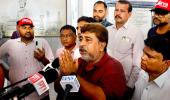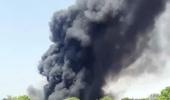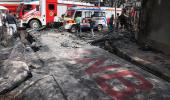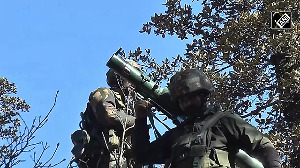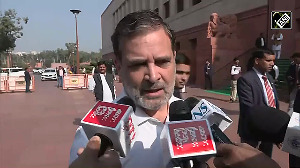He is still finding it hard to come to terms with the horrendous memories he had on board a crashed aeroplane around five years ago.

The jerking sounds, screams of children and a call from a fellow passenger from behind to pray to the Almighty were still part of his nightmares, said Ashique, a Keralite man who had a narrow escape in the flight crash that happened at Kozhikode airport in 2020.
The tragic plane crash in Ahmedabad, which killed 241 people on board a London-bound Air India flight on Thursday, brought the horrors of the Kozhikode flight accident back to the minds of people, including Ashique.
"My mind has been deeply disturbed ever since I came to know about the plane crash in Ahmedabad. The TV visuals were really painful. It was like re-living our own experience, which we had years ago," he told a TV channel.
If the Ahmedabad accident happened within seconds after the take-off from the airport, the Kozhikode plane accident occurred soon after the aeroplane had landed on the runway, he said.
An Air India Express flight from Dubai with 190 people, including its six-member crew, overshot the tabletop runway during landing at the Kozhikode airport amid heavy rains on the evening of August 7, 2020.
The narrow-body B737 plane fell into a valley 35 feet below and broke into pieces, killing 21 people, including both pilots.
"The majority of the passengers onboard that ill-fated flight, including me, were already thoroughly disturbed because of the COVID situation. Many of the passengers were on their way back home after losing their jobs because of the pandemic," Ashique recalled.
He said they could not identify even many fellow travellers because of the donning of the masks and the PPE kits.
Everybody was thinking about the quarantine after reaching home, and passengers didn't even dare to use the washroom on board the flight because of the fear of the disease, he said.
So, the relief of seeing the runway was beyond words, he said.
But, after the landing, the flight rose up again and hovered for some time, he said, adding that it again landed in the second attempt.
"Suddenly, a jerking sound was heard. Some children were seen falling from the laps of their mothers. The happenings in the next few seconds were something beyond our imagination," Aashique recalled.
Children were heard screaming around, and someone from behind asked everyone to pray to God.
"We understood something bad had happened. I hugged my brother, who was travelling along with me, tightly. I don't remember anything after that," he said.
The man said that when he opened his eyes, it was raining heavily.
"Luckily, our flight didn't catch fire. The airport area was receiving heavy rains on that fatal day. Forgetting the COVID situation, local people rushed to our rescue and gave us first aid, brought us back to life," he added.
He said that after news of the Ahmedabad tragedy happened, many of the then co-passengers texted messages in their common social media group and reminisced about those memories.
At least 265 people were killed on Thursday when the London-bound Air India plane crashed into a medical college complex in Ahmedabad and burst into a ball of fire less than a minute after takeoff.
The dead in the country's worst air disaster in recent times included several people on the ground.
***************
Mangaluru plane crash survivors recall horror, gratitude 15 years on
Fifteen years after the tragic crash of Air India Express flight IX 812 in Mangaluru airport, which killed 158 people, a survivor of the accident, K Pradeep, still recalls the day with solemn reflection and quiet gratitude.
That aircraft overran the runway on May 22, 2010 and crashed.
Pradeep, now a civil contractor in the city, visits the crash memorial at Kulur every May 22. He lays flowers at the plaque, stands in silence for the lives lost, and offers prayers.
"It was the charity work done by my parents and their blessings that saved me," he told PTI, recalling the horrific moment when the Boeing 737 aircraft failed to stop and plunged into a gorge.
After paying tribute, he also visits temples to thank the divine for what he calls a miraculous escape.
Another survivor, Usman Farooq, who now works with an ambulance service, also believes his survival was due to divine intervention.
He remembers how the portion of the aircraft near the wing, where he was seated, broke apart just in time to allow his escape. Farooq said he owes his life to the Almighty and sees his work in emergency services as a way of giving back.
The Directorate General of Civil Aviation (DGCA), which investigated the crash, attributed the cause primarily to human error. The inquiry found that the aircraft touched down approximately 5,200 feet down an 8,000-foot-long runway, leaving insufficient distance to bring the aircraft to a halt.
Despite repeated warnings from the co-pilot and alerts from the Enhanced Ground Proximity Warning System (EGPWS), the captain continued with an unstabilised approach. Investigators also revealed that the commander of the aircraft had been asleep during a portion of the flight and was likely experiencing sleep inertia, a state of cognitive impairment, at the time of landing.
The Court of Inquiry, led by Air Marshal B N Gokhale largely supported the DGCA's conclusions, highlighting pilot error as the primary cause. However, it also pointed to systemic failures.
The report noted that the rigid structure housing the localiser antenna at the airport was not frangible, contrary to international civil aviation guidelines. This contributed to the aircraft breaking apart upon overshooting the runway.
The inquiry also mentioned that audits conducted by the DGCA in previous years, including one in 2007 and another shortly before the crash in 2010, had flagged several deficiencies in Air India Express's training and safety oversight mechanisms. Unfortunately, corrective measures were not implemented in time.
Emergency response efforts at the crash site were hindered by inadequate access routes and limited firefighting resources. Survivors and emergency responders later noted that these deficiencies delayed rescue operations and may have cost lives.
In the aftermath of the crash, the DGCA initiated safety audits of other critical airports across the country. The regulatory body also formed the Civil Aviation Safety Advisory Council to improve oversight.
Reforms were proposed to enhance runway safety, especially at tabletop airports like Mangaluru, and to reinforce crew training, especially on go-around procedures. Some of these measures have been implemented, but infrastructural gaps at many airports remain a concern.

